El Nino sweeps trash onto Hong Kong beaches
Updated: 2016-08-22 07:38
By Sylvia Chang(HK Edition)
|
|||||||||
Regional action vital to contain marine refuse
Editor's Note: In part two of a series on the impact of global warming on southern China, Sylvia Chang traces the excessive trash on HK's shores after Typhoon Nepartak this July, to a complex regional interplay of storm surges, floods, sea current flows and inadequate waste management in HK and other cities of the Pearl River catchment area.
The unusually high volumes of rubbish deposited on Hong Kong shorelines in the middle of this year raised public alarm, hit newspaper front pages and prompted Chief Executive Leung Chun-ying to lead 70 civil servants on a Lantau Island beach cleanup in early July, for press and TV amplification.
There was widespread concern that Hong Kong's waste disposal and recycling systems are no longer adequate, and that the community itself was to blame. Concerned residents mobilized to scoop up the trash.
Social media went viral with images of bottles, plastic bags, leftover food, dead fish and abandoned furniture, piling up where children normally play on beaches. The Environmental Protection Department (EPD) was besieged by press, politicians and residents, to explain this abnormal deposit of marine refuse.
The Chief Executive pledged to follow-up his high profile Lantau beach clean-up with relevant authorities in Guangdong province, for a coordinated regional approach to tackling marine waste flows caused by extreme weather patterns destabilizing the Pearl River catchment area.
Pearl River Delta floods
The EPD recorded a six to ten-fold increase in volumes of beach rubbish collected in June-July this year, against the annual average for the same period. It linked the spike in the June 2016 garbage volume, to a similar spike in 2005, when an even greater amount of rubbish washed up on our shores.
The extreme rainfall and thunder storms of June 2005 caused the worst flooding in 100 years of Wuzhou, Guangxi Zhuang autonomous region. The Pearl River catchment overflowed, flooding several cities, sweeping inland solid waste out to sea. Hong Kong was deposited as a natural consequence of powerful south-westerly winds and sea current flows.
The mid-2016 excess marine refuse on beaches pointed to more than a localized consequence of heavy rainfall. The incident was not unprecedented. Hong Kong experienced heavy rainfall and rainstorm records in 2006 and 2008 which also contributed to the larger amount of marine refuse in the two years. Extreme weather this year such as Typhoon Nepartak, exacerbates what is already a problem of inadequate waste management.
As Typhoon Nepartak hit Guangdong province, floods displaced 239,500 people across 11 cities, causing a total loss of 238 million yuan ($35.8 million), according to the province's Department of Civil Affairs.
People add 70% beach rubbish
After the surge of marine refuse in 2005, EPD field surveys were conducted to trace the trash sources. Only items carrying labels enabled researchers to separate them into "local" and "mainland" categories.
The proportions between the two categories varied widely in different parts of Hong Kong. On Lantau Island, 0.1 to 1.7 percent of the total was "local" refuse while 2.5 to 5.4 percent was classified as "mainland."
"This shows the southern part of Lantau Island is typically more vulnerable to the impact of marine refuse from the Pearl River Estuary, due to the prevailing southwest monsoon wind in the wet season," according to the EPD. This may explain why government officials elected to clean up a beach in Lantau Island rather than elsewhere.
According to Wen Zhou, a scientific adviser to the Hong Kong Observatory and associate professor at the City University of Hong Kong, extreme weather would cause islands in the region, like Wailingding Island and Hong Kong's Lantau Island, to be overwhelmed by rubbish, unless there is timely intervention.
She observed that coastal cities other than Hong Kong, were also experiencing increased trash deposits on their shores, caused by abnormal floods in southern China and intensified air circulation on the sea.
Sources of marine waste
A Hong Kong government research report released in 2015, shows more than 70 percent of marine refuse comes from recreational activities on, or alongside the beach. The rest were by-products of fishing and boating activities, street waste and construction work. Household waste, medical and sanitary items also figure in the rubbish.
Debris left behind by visitors, waste from games played or festivals held on the beach, and overflowing street drains, account for the largest part of the marine refuse resulting from human activities.
El Nino effect
Wen Zhou noted that global warming generates the El Nino effect, triggering extreme weather disruptions across the globe. Abnormal rises in sea surface temperatures of the central and eastern equatorial Pacific and Indian Oceans, were recorded in 2016.
The El Nino phenomenon whips the seasonal typhoons into devastating storm surges, excess precipitation, widespread flooding of the Pearl River catchment, powerful winds and sea currents which flush high volumes of inland waste out, which deposit on Hong Kong coastlines.
This year El Nino reached a temperature similar to 1998, when cataclysmic floods struck the Chinese mainland. Zhou said the precipitation this summer in South China is 20 percent higher than average for the same period, of the last 30 years.
More extreme weather
Scientists expect the recorded El Nino frequency of three to seven years to accelerate. Zhou predicts rainfall in Hong Kong will increase 10 to 15 percent by 2050 with an increase of 20.9 percent likely by the close of the 21st Century.
While studies are underway to project the rate of El Nino recurrence, Zhou is certain that "extreme weather, especially storms and floods, will hit coastal areas more frequently in the future, with greater intensity and longer duration."
She has drawn the government's attention to the possibility of major natural disasters, urging them to re-think and reform municipal planning, and introduce regulations for timely disaster management.
Regional coordination
Patrick Yeung Chung-wing, project manager of Coastal Watch, World Wildlife Fund (WWF), Hong Kong, said more proactive action is needed to protect the beaches. "The active way of doing it is to eradicate the root of the problem."
Yeung says marine pollution is a regional issue, involving all coastal cities in the Pearl River Delta. The efforts to address this should include regional cooperation and coordination with the mainland.
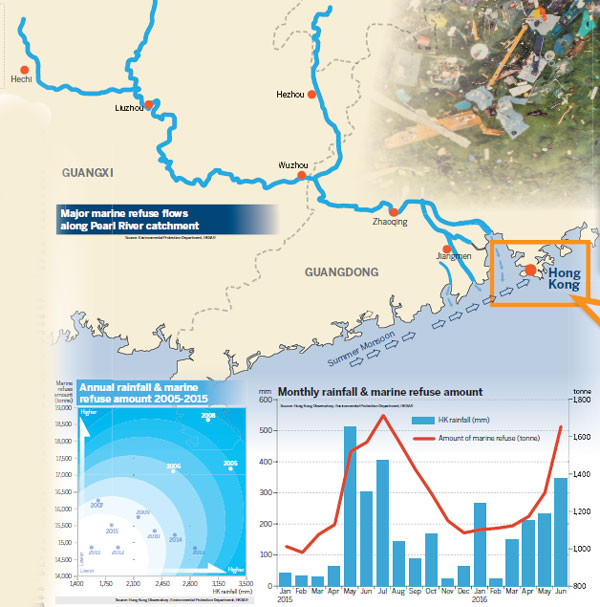
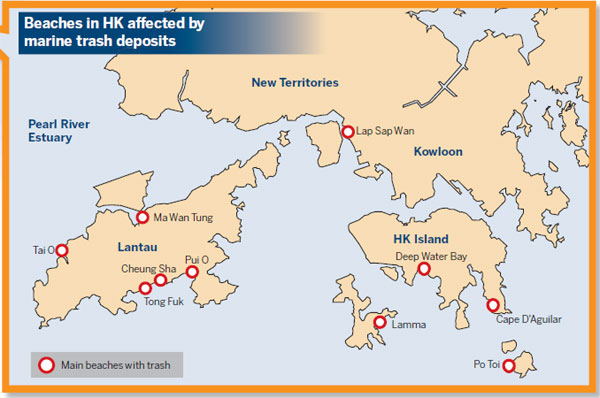
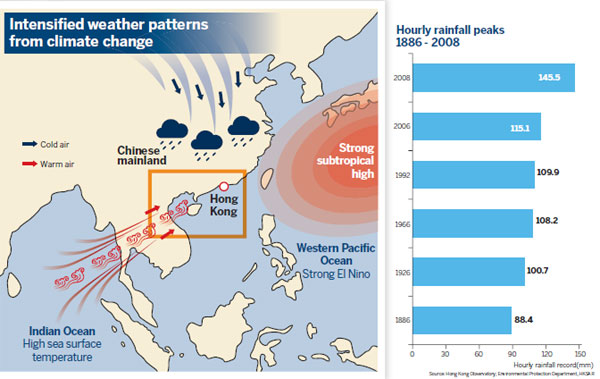
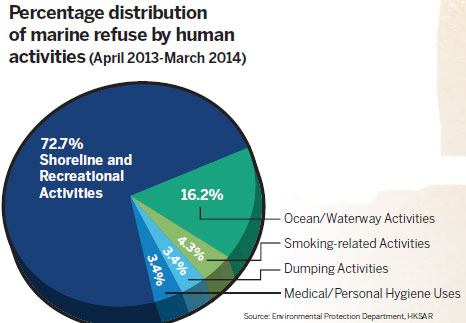
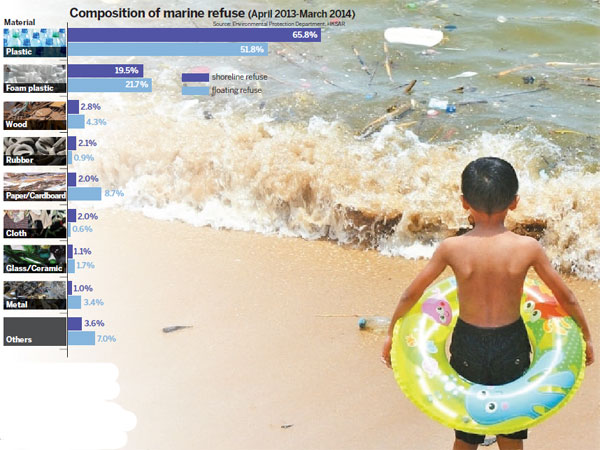
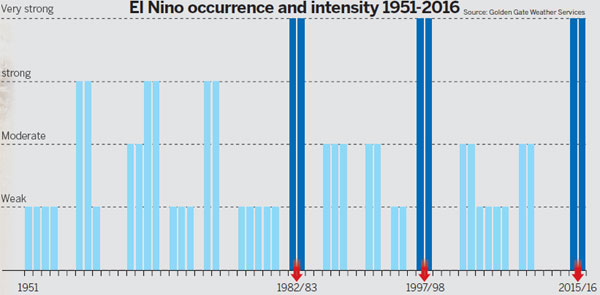
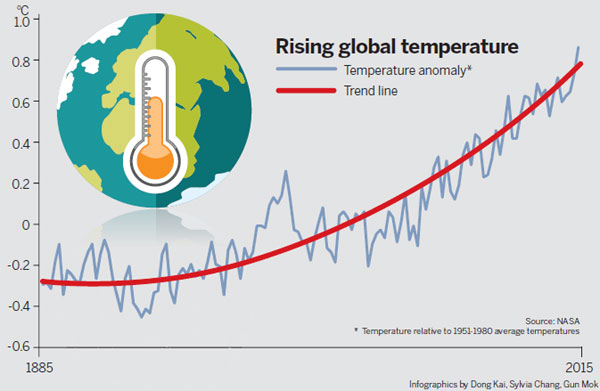
(HK Edition 08/22/2016 page8)